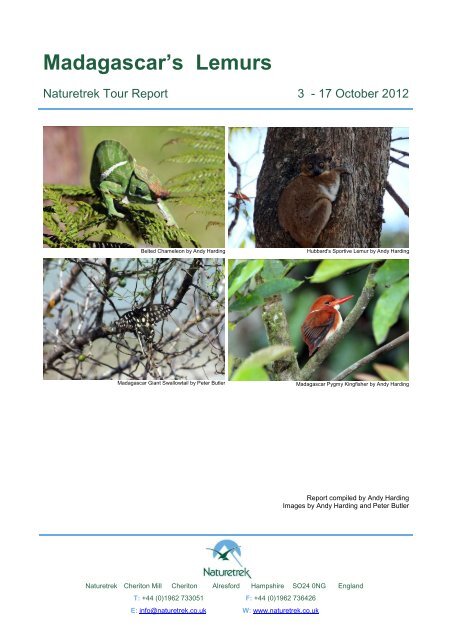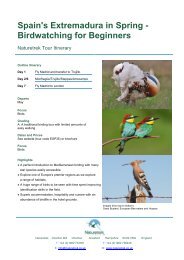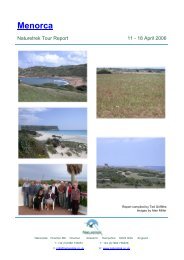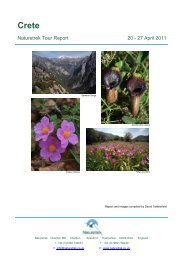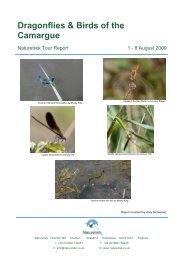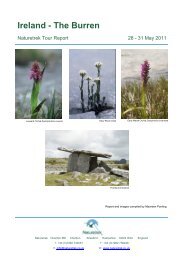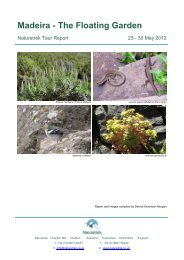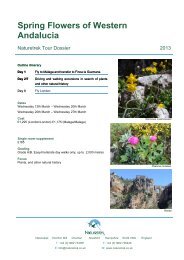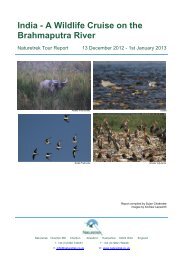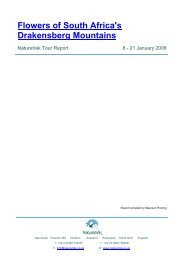Tour report - Naturetrek
Tour report - Naturetrek
Tour report - Naturetrek
You also want an ePaper? Increase the reach of your titles
YUMPU automatically turns print PDFs into web optimized ePapers that Google loves.
Madagascar’s Lemurs<br />
<strong>Naturetrek</strong> <strong>Tour</strong> Report 3 - 17 October 2012<br />
Belted Chameleon by Andy Harding Hubbard's Sportive Lemur by Andy Harding<br />
Madagascar Giant Swallowtail by Peter Butler Madagascar Pygmy Kingfisher by Andy Harding<br />
<strong>Naturetrek</strong> Cheriton Mill Cheriton Alresford Hampshire SO24 0NG England<br />
T: +44 (0)1962 733051 F: +44 (0)1962 736426<br />
E: info@naturetrek.co.uk W: www.naturetrek.co.uk<br />
Report compiled by Andy Harding<br />
Images by Andy Harding and Peter Butler
<strong>Tour</strong> Report Madagascar’s Lemurs<br />
<strong>Tour</strong> Leaders: Andy Harding <strong>Naturetrek</strong><br />
Participants: Dave Allen<br />
Rivo Rarivosoa Local Guide<br />
Jane Allen<br />
Andy Booth<br />
Mavis Butler<br />
Peter Butler<br />
Del Colbert<br />
Pat Colbert<br />
Sam Geddes<br />
Eileen Mathers<br />
Ian Mathers<br />
Andrew Mattle<br />
Ros Reynolds<br />
Day 0 Wednesday 3rd October<br />
Travel from UK to Paris<br />
Day 1 Thursday 4th October<br />
Rainy in Paris, warm in Tana<br />
The group had all travelled to Paris the previous evening, but from different parts of the British Isles and at<br />
different times. Ten, as well as the tour leader, stayed in the Hotel Ibis, at Charles de Gaulle airport, overnight<br />
and we were able to meet up early the next morning, and make our way to the departure terminal. Andy and Ros<br />
had stayed in a different hotel and we met them in the departure lounge. The long flight was in good weather, so<br />
uneventful but as usual visa and passport formalities at Tana were protracted and bureaucratic, but eventually we<br />
met up with Rivo, our local guide, transferred to the Ibis Hotel and got to bed after a long day...<br />
Day 2 Friday 5th October<br />
Fine and sunny max 23 O C<br />
A late breakfast was taken at 9.00 am. The trip ‘briefing’ was held on the splendid veranda of the Hotel Orchid<br />
where Madagascar Fody and Wagtail and Mascarine Martin were first noted. We then headed off about 25km to<br />
the west to the Lemur Park. The traffic en route was slow but almost infinitely variable, allowing us to see at<br />
close quarters the myriad small ‘shops’ and enterprises, usually with a solid throng of people on both sides of the<br />
road. Those areas not so dedicated used every square metre for either some kind of agriculture, split into small<br />
family owned plots or communal brick ‘factories’ using the mud which the rainy season bought down annually.<br />
Both of these enterprises occupied vast areas but seemed entirely non-mechanised.<br />
© <strong>Naturetrek</strong> December 12 1
Madagascar’s Lemurs <strong>Tour</strong> Report<br />
Those of a birding bent noted Dimorphic, Cattle, Great White and Black Egrets, the latter with its sun-shading,<br />
feeding technique, regularly dotted across the ‘paddies’ accompanied by Common Squacco Herons. At the<br />
Lemur Park itself we took a lengthy walk before lunch. The Lemurs here are nearly all ‘rescues’ which roam<br />
freely, successfully breeding, but in an area where there are ‘no truly wild’ Lemurs. Nonetheless the eight species<br />
found on our walk kept all the cameras clicking, and were both charming and entertaining: an excellent<br />
introduction to this fascinating group of mammals. Several species of exotic butterfly enhanced the tour of<br />
which only Madagascar Monarch was identified. A Collared Iguana was the reptilian highlight. There were more<br />
birds seen than we anticipated, but given that all were new to nearly all of the group, identifying the stars is<br />
difficult. Perhaps the males of two species of Sunbird and the Madagascar White-eye win on colour brilliance<br />
alone. Lunch was taken in cool and very pleasant surroundings with chicken and zebu being the alternative main<br />
courses – both were excellent.<br />
We had to drive through more of the suburban Tana traffic before escaping to the south-west on twisty roads,<br />
regularly punctuated by ramshackle (to northern European eyes) villages and poor parking! En route Pied Crow,<br />
Striated (aka Green) Heron and Madagascar Nightjar at dusk were added to the bird list. We checked into La<br />
Residence Camelia in Antsirabe at around 7.30 pm and we were supping pre-dinner drinks by 8.00 pm. The<br />
chicken/zebu choice re-appeared but in very different and delicious guises. Once given detail of the next day’s<br />
itinerary the group either went for a well-earned sleep or stayed for the evening call-over or log of species seen.<br />
Day 3 Saturday 6th October<br />
Fine, sunny 24 ○ C<br />
After a brief tour to see that Antsirabe was not an entirely one dimensional town, we set off on the long journey,<br />
which of course we broke at several points. Among these was Ambositra, which is famous for wood carving and<br />
in a fairly short stop most of the group bought some souvenirs. At another point a couple of Hamerkops joined<br />
the regular Egret/Heron species in the paddyfields, so we stopped to enjoy scope views. Since a break was<br />
timely we walked on for a while, but rapidly split into two groups, with those at the rear still watching herons.<br />
Those at the front had excellent views of Lesser Madagascar Cuckoo, while those at the rear saw six Red-billed<br />
Teal!<br />
Our next planned birding stop was near the village of Ambatofitorahana. The attraction here was some small<br />
areas of marsh, which had not been cultivated. Here Madagascar Swamp Warbler was well seen, Cuckoo Roller<br />
displayed over the nearby forest, Madagascar Hoopoe gave a couple of fly-pasts, as did a Purple Heron. Having<br />
provided excellent opportunity to see how different Madagascar Stonechat is from our British version, the main<br />
target of the visit, Madagascar Snipe, was seen and heard well. We had spent longer here than scheduled but well<br />
worthwhile.<br />
Our rather late lunch stop was at Ialatsara, a beautifully set rural restaurant in some of the little remaining forest<br />
in that area. Souimanga Sunbird, Madagascar Paradise Flycatcher and Cuckoo Shrike were perhaps the best<br />
species seen here before and after lunch. Much of our subsequent long journey was through very degraded<br />
landscape, so few birds were noted, of which Madagascar Buzzard and Yellow-billed Kite were new to us.<br />
2 © <strong>Naturetrek</strong> December 12
Madagascar’s Lemurs <strong>Tour</strong> Report<br />
We arrived at the Hotel Cristo near the Ranomafana National Park around 7.00 pm and had dinner at 8.00 pm.<br />
The late evening entertainment was exceptional with two spectacular and beautiful Hawkmoths vying with a very<br />
large Praying Mantis and a Rhinoceros Beetle for most of the attention, while Day (!) Geckos looked on.<br />
Day 4 Sunday 7th October<br />
Fine Sunny 24 ○ C<br />
Early risers at the beautifully located Hotel Cristo were able to see Crested Drongo and Madagascar Magpie<br />
Robin in the gardens. We then went to the entrance to the Talatakely section of the Ranomafana National Park<br />
having picked up our two guides and some ‘spotters’. To make forest watching more practical we split into two<br />
groups. Both groups had wonderful views of 4 Golden Bamboo Lemurs and 2 Greater Bamboo Lemurs, 4<br />
Milne-Edwards Sifakas and a usually nocturnal Small-tooth Sportive Lemur, doing a little sunbathing!<br />
The terrain is demanding – often steep and quite rocky, and above all undulating, which makes seeing these<br />
wonderful creatures all that more rewarding – they are not an easy ‘gimme’. Birding is often frustrating so<br />
getting all of the group to see a bird well often fails, and some desirable species were only reliably identified on<br />
call by our expert guide Jean-Cree. That said Pitta-like Ground-Roller is unlikely to be bettered on the trip and<br />
decent views of Rand’s Warbler, Common Sunbird-Asity, Madagascar Lesser Cuckoo and Tylas Vanga were<br />
much appreciated. A good number of beautiful, if mainly unidentified butterflies cruised by. An absolutely tiny<br />
Short-nosed Chameleon was probably the most appreciated lizard, and numerous odd bugs were photographed<br />
– will they ever get on the list?<br />
We returned to the Hotel Cristo to pack for a move about 15km nearer to the National Park, but first enjoyed a<br />
lovely al fresco lunch. Our departure was delayed by a double Chameleon hit. Firstly a large and spectacular<br />
Belted Chameleon near the entrance, and then a second smaller cousin in the potted plants. However eventually<br />
we made our move and checked in to the Hotel Nature Domain from where we embarked on a late afternoon/<br />
night-time walk in the Vohiporara area of the National Park.<br />
On the forest edge from the road birds were a little easier to get to grips with, so Forest Rock Thrush, Common<br />
Newtonia and Hook-billed Vanga were much enjoyed. A host of Chameleons of various species, ages and sizes<br />
were picked up mainly by torchlight – this group of reptiles were a huge hit with the group. We also had our first<br />
look at Giraffe-necked Weevils: they looked rather bigger in the Attenborough programmes. The biggest bonus<br />
of all was that when we eventually passed the now deserted stake-out for Rufous Mouse Lemur, one was still<br />
present and willing to be seen, if fairly briefly by torchlight. Then back for dinner.<br />
Day 5 Monday 8th October<br />
Fine and sunny 25 degrees C<br />
We awoke to spectacular views across the forest from our bungalows, gathered early for breakfast and picked up<br />
the same guides and spotters as yesterday – the target being different areas of the Talatakely area of the forest.<br />
Madagascar Starling and Madagascar Blue Vanga were additions to the bird list before we left the car park.<br />
© <strong>Naturetrek</strong> December 12 3
Madagascar’s Lemurs <strong>Tour</strong> Report<br />
We kept the same groups as yesterday and one group bumped into some Golden Bamboo Lemurs before we<br />
even approached the areas in which we hoped to see new species. In the event neither group was disappointed<br />
because in addition to the above a group of 8 Red-fronted Brown Lemurs and a very active pair of Red-belled<br />
Lemurs were just reward for the hard work of getting through the forest. Birding highlights for the groups<br />
included Hook-billed Vanga on the nest. Madagascar Lesser Cuckoos were regularly seen as opposed to just<br />
heard. A huge showy black Millipede and a Satanic Leaf-tailed Gecko were the most photographed of the other<br />
fascinating finds in the forest.<br />
Lunch was taken back at the hotel after a half-hour excursion into ‘town’. The afternoon walk was back in the<br />
Vohiporara section of the reserve and here we chanced upon another very active group of Milne-Edwards<br />
Sifakas, who were both entertaining and delightful. We were by now used to not seeing everything which Jean-<br />
Cree hears, such as Madagascar Turtle Dove and Pollens Vanga but Rufous Vanga was excellent, as was<br />
Madagascar Flufftail just outside the forest. We decided against extending the afternoon and evening excursion<br />
into night and returned for dinner.<br />
Day 6 Tuesday 9th October<br />
Fine and sunny 28 degrees C<br />
What a fantastic send-off from Ranomafana – a Madagascar Pygmy Kingfisher in a small sapling opposite the<br />
hotel entrance which stayed for 10 minutes. Today was essentially a transfer day of 350km, with only a few<br />
planned stops. First we needed to drive through Madagascar’s second largest city, Fianarantsoa. As well as<br />
refuelling, and Michel and Rivo organising the picnic lunch, there were souvenir buying opportunities. Further<br />
such opportunities arose when we visited the community paper-making project and its shop at Ambalovao. The<br />
whole process is done by hand and the decoration beautifully delicate, so they did a good trade.<br />
Back on the wildlife trail our next stop was at Anja, where there is a locally organised reserve, primarily for Ring-<br />
tailed Lemurs. There are several groups of these in the forest here and we were soon able to spend about an hour<br />
in close proximity to one of them. All ages were represented and several small babies were with their mothers –<br />
cuteness personified. It was here we also saw our first Giant Madagascan Swallowtail Butterflies, and, under a<br />
shady, straw-roofed canopy enjoyed our lunch.<br />
There was still a long journey ahead, but as we started to climb towards the savannah vegetated plateaux a<br />
Madagascar Partridge crossed the road. We stopped for 10 minutes - long enough for a successful flushing<br />
operation of a showy male. This success encouraged some fairly concentrated watching as we traversed the vast<br />
uniform landscape, but we failed to find the hoped-for Reunion Harrier. Some Black Swifts and a spectacular<br />
evening sky which provoked a camera stop were the best we could manage.<br />
It was dark when we reached the Jardin du Roy, and the drink and refreshing facecloth which welcomed us<br />
alerted us to a different level of comfort and accommodation. The hotel was set among huge outcrops of rock,<br />
which we could just make out in the gathering gloom, and were even more spectacular the next morning.<br />
4 © <strong>Naturetrek</strong> December 12
Madagascar’s Lemurs <strong>Tour</strong> Report<br />
Day 7 Wednesday 10th October<br />
Fine and sunny max 30 degrees C<br />
The earliest breakfast could be served was 6.40 am, but what a breakfast, superbly presented. Given the opening<br />
time of Isalo National Park, this actually only cost us half an hour… In the adjacent village we picked up our<br />
main guide, Charles, and two porters to carry our substantial picnic lunches and several extra litres of water.<br />
The track to the forest itself is 17km, and along the way we enjoyed point blank views of Madagascar Bee-eater<br />
and Madagascar Bush Lark. We then had about 45 minutes walk to get into the right sort of habitat in the<br />
Canyon de Rattes. We stopped just inside the forest while the guides went off in search of our main quarry, and<br />
we occupied ourselves birding – Madagascar Magnificent Flycatcher, Coucals and Hook-billed Vanga on the<br />
nest, Lemuring with some fairly distant Ring-tails, insecting with Flatid Leaf Bugs, Giant Madagascar Swallowtail<br />
and some amazing Shieldbugs (not like those in the UK).<br />
Eventually word came that the hoped-for Verreaux’s Sifakas had come down from their night-time roost high on<br />
the cliffs and had been found, and we set off. After a fair distance on a track we hacked off into the thicker stuff<br />
and – eventually - came upon the Sifakas, with young – a fabulous sight. After spending about half an hour with<br />
this troupe we headed off to Canyon Maki, also within the reserve – for our lunch stop. Narrow tracks and<br />
many stepping stones later we came across a mini-paradise with cool clear water falling into limpid pools. Our<br />
packed lunch was both substantial and very tasty. About half of the party could not help assuaging the heat by<br />
standing knee-deep in the water.<br />
With revived feet we headed back and having dropped off our guide and porters we returned to the superbly<br />
appointed Hotel Jardin du Roy. We could now fully appreciate its amazing surroundings and how it nested<br />
between gigantic rock formations. The swimming pool was irresistible to half a dozen of us but at 5.00 pm half<br />
ventured out to the local Lac du Lion, to see Madagascar Pond Heron, Madagascar Little Grebe, Purple Heron<br />
and 10 Red-billed Teal, as well as getting excellent views of some commoner species. Dinner was taken at 7.30<br />
pm in preparation for a very early start tomorrow; and later that evening our breakfast was bought to our rooms!<br />
Day 8 Thursday 11th October<br />
Fine, sunny max 29 degrees C<br />
After our coffee, all the bags were ready for loading before 5.00 am and we set off on the drive south. The<br />
recently hugely expanded sapphire mining town of Ilakaka was mercifully still quiet as we passed through and<br />
after 90 minutes we pulled into the reserve of Zombitse. Local advice suggested that one side of the road was<br />
best for Lemurs and the other for birds. So we divided again with a trip length of around an hour. Due in part<br />
to the discovery of a Hubbard’s Sportive Lemur at its roost, but completely visible at reasonable range but on the<br />
wrong side of the road, the visit eventually lasted 2.5 hours! A couple of Verreaux’s Sifakas performed well for<br />
the Lemur group, and they also saw an interesting subset of the birds; Two Owls, Torotoroka and White-<br />
browed, were very visible, if at roost, and kept a watchful eye on us. Madagascar Button Quail scuffed along the<br />
ground, Crested Couas were staggeringly bright and Appert’s Greenbul, a real speciality here, were well seen.<br />
Lastly a fine Coquerel’s Coua was tracked down by our guides.<br />
© <strong>Naturetrek</strong> December 12 5
Madagascar’s Lemurs <strong>Tour</strong> Report<br />
We then headed off for a long stretch until taking lunch just a few kilometres short of Toliara at a very smart<br />
restaurant, with a Sakalava Weaver colony and a pool which held a Greenshank. Adjacent to the restaurant is a<br />
first-class arboretum, but it was now so hot we decided to miss it out now, but planned to visit it when we came<br />
back to Toliara in a couple of days time. In the event, when we drove into Toliara to find adequate supplies of<br />
water, and having done so, drove along a sandy track to Ifaty and the Hotel de Paradisier. Of course we stopped<br />
at some roadside pools and saw Kittlitz’s Plover, Tumstone, Curlew Sandpiper and Black-winged Stilts.<br />
We then had some relaxing time, since it was still very hot when we finally reached the hotel. We reconvened for<br />
a short night walk before dinner which produced wonderful views of one of three Reddish-grey Mouse Lemurs<br />
and several Madagascar Nightjars. The start of dinner was enlivened by local musicians and dancers and we<br />
retired to bed – another early start tomorrow.<br />
Day 9 Friday 12th October<br />
Fine, hot 30 degrees C<br />
The first arrivals for coffee at 5.00 am in the reception area drank by torchlight! 5.20 am saw us en route for the<br />
Spiny Forest at Reniala, and after a trudge up a deep sandy track, we met up with our guides. It was decided that<br />
we all needed to see the two most iconic birds of the forest the Sub-desert Mesite and the Long-tailed Ground<br />
Roller. As it happened 5 Mesites sat huddled together in a row on a branch watching us watching them –<br />
brilliant! The Ground Roller was altogether more lively but absolutely beautiful.<br />
Subsequently we split into our now familiar two groups. This is an excellent forest for birds and it is rather more<br />
open than rainforest so eventually we had good views of White-headed, Lafresnaye’s and the extraordinary<br />
Sickle-billed Vangas. Even more striking was the Running Coua and the Green-capped Coua, which is surely<br />
faster than a Roadrunner. One or two other species gave us less than brilliant views, but we’ll be coming back<br />
here again. The largest Baobab Tree in the forest was encircled by seven of the group, just touching hands. This<br />
tree is well over 1000 years old. At our beachside resort, outrigger canoes are very much in evidence, and in the<br />
forest all the five (at least) trees whose wood is required to construct an ‘outrigger’ canoe, were identified and<br />
their purpose explained.<br />
It gets hot early so we returned to the hotel and several of the group had booked snorkelling later in the<br />
morning, but the wind had got up so, unfortunately, so viewing the reef and its inhabitants via the glass-<br />
bottomed boat was all that was permitted.<br />
The next organised activity was at 3.30 pm with departure back to the Spiny Forest. A stop at pools en route<br />
produced 3 Three-banded Plovers (with red eyes) as well as a few other waders. Little entirely new was seen on<br />
this visit, but better views of some species and more ecological information made it a splendid visit to a unique<br />
habitat. Just before departing a juvenile Harrier Hawk was disturbed from drinking just outside the reserve<br />
reception, frightening everything within a few hundred metres.<br />
More dance and music preceded our arrival for dinner after another nocturnal torch survey of part of the<br />
gardens. Dinner was again excellent at this hotel as we have come to expect. …and another early start<br />
tomorrow!<br />
6 © <strong>Naturetrek</strong> December 12
Madagascar’s Lemurs <strong>Tour</strong> Report<br />
Day 10 Saturday 13th October<br />
Fine, hot 28 degrees C<br />
A repeat of yesterday’s very early coffee and two alternative venues: the Spiny Forest at Reniala or the saltpans at<br />
Mangjly. Those who chose the latter were ultimately rewarded with good numbers of birds seen including<br />
several Madagascar White-fronted and Three-banded Plovers, Marsh Sandpipers and a Painted Snipe. A White-<br />
throated Rail was another bonus.<br />
The Spiny Forest walk was even more botanically informative than yesterday, but birds were not ignored. A<br />
flock of Grey-headed Lovebirds could be seen perched in the next tree to a Harrier-Hawk. Both White-headed<br />
and Sickle-billed Vangas were seen well and there was a fortunate encounter with a Running Coua.<br />
We then returned to the hotel for a late breakfast before packing, checking out and then relaxing before lunch.<br />
The sea, the activities of the outrigger canoes and the distant reef provided an ideal opportunity for just enjoying<br />
sitting and watching. We then drove back through Toliara to visit the Arboretum in somewhat lower<br />
temperatures. Rivo’s knowledge of the trees and plants of the island and the history of the arboretum, came to<br />
the fore.<br />
We were to take an evening flight back to Tana, but had been unable to confirm the flight by phone. So, since it<br />
was not far away we went to the airport to check the flight time – to discover it was running an hour late. So<br />
while the group went to the Hotel Victory to lounge about for a couple of hours Rivo organised a group check-<br />
in. We had our evening meal at the Hotel Victory and returned to the airport just 30 minutes before the flight –<br />
plenty of time since formalities and security are pleasingly non-existent. Then it was a short transfer back to the<br />
Hotel Orchid.<br />
Day 11 Sunday 14th October<br />
Fine and dry 25 degrees C<br />
An early start and the fact that it was a Sunday meant that Tana traffic was not quite so bad, and we were soon<br />
heading out through the familiar patchwork of paddyfields and brick fields en route for Andasibe. We stopped<br />
en route at the River Mangora where we had only a distant view of a single Madagascar Pratincole. Just before<br />
11.00 am we reached the private Perinet Reserve, part of the larger Analamazoatra Reserve. Almost immediately<br />
we saw Ward’s Flycatcher, but the main focus was again Lemurs; 3 roosting Eastern Woolly Lemurs were<br />
relatively inactive, and that spot was enhanced by a Red-fronted Coua, but then we came across a Common<br />
Brown Lemur which moved off speedily. However it joined up with another and sat placidly in an accessible<br />
glade, while we watched from the track. Even more desirable was a larger group of superb Diademed Sifakas,<br />
which contained adults that were content to groom and move quietly about, but there were some very lively<br />
juveniles playing roly-poly down the hill clinging to one another. For the last half an hour of our time with the<br />
Sifakas we had been partly distracted by the calls of the Indri, the largest of the Lemurs. This group of Indri<br />
proved highly mobile and for their considerable size, great leapers. We also had to be pretty mobile in quite<br />
difficult terrain, but eventually enjoyed fabulous views, before returning to the reserve entrance to take our<br />
packed lunch.<br />
© <strong>Naturetrek</strong> December 12 7
Madagascar’s Lemurs <strong>Tour</strong> Report<br />
As it grew hotter no-one opted to stay in the forest, so we drove to the Vakona Forest Lodge to check-in. A<br />
night walk in the Mitsinjo area of forest started at 6.30 pm and both Eastern Woolly Lemurs and Furry-eared<br />
Dwarf Lemur were picked out in the torches, as well as an array of Chameleons, Geckos, Spiders and Moths.<br />
Then back for dinner.<br />
Day 12 Monday 15th October<br />
24 degrees C Fine and sunny<br />
Another early start, but before setting off a Blue Coua gave much better views than a couple of rather shy birds<br />
noted previously. The morning’s destination was part of the Mantadia National Park, with Lemurs again the<br />
main target. Two Red-bellied Lemurs and a single Black and White Ruffed Lemur were the new species enjoyed.<br />
However most people think the Diademed Sifaka the most beautiful of all so seeing more again of these fantastic<br />
creatures as well as the largest of all, the Indri, who were calling again, albeit distantly made for an excellent<br />
morning. The cream of the birds were Broad-billed Roller and Short-legged Ground-Roller, which was roosting<br />
as you would expect, high up in a tree, but highly visible!<br />
After returning and taking lunch a small number of the group visited the nearby ‘Lemur Island’ – not wild<br />
animals but it’s difficult to get enough of Lemurs. The 4.00 pm walk was very focussed on two species of birds<br />
which Maurice eventually succeeded in tape-luring out – Madagascar Rail and Madagascar Flufftail.<br />
This sojourn almost overlapped with the night patrol which in addition to an interesting array of Chameleons,<br />
saw us admiring the evening work of large Orb Spiders constructing their webs to catch their food. They eat the<br />
webs just before dawn to retain valuable protein! A tiny Rufous Mouse Lemur was a good find, but the star of<br />
the show was a Lowland Streaked Tenrec seen very well on the path by all who had ventured out. We were only<br />
a little late for dinner, and looking forward to the morrow.<br />
Day 13 Tuesday 16th October<br />
Mist rapidly clearing, fine 22 degrees C, warmer at Tana<br />
Several of the group either before or after breakfast enjoyed the very attractive male Nelicourvi Weaver building<br />
its nest within the complex - over water, yet within a few metres of interested onlookers. A slightly later start still<br />
enabled us to be at the entrance to the Perinet Reserve by 7.30am. However we hoped to meet Maurice on the<br />
road, rather than at the reserve itself, because that would mean he had located the Long-eared Owls roost – and<br />
he did…an adult, much larger than our version of LEO, and a very white and cute baby were fully visible from<br />
the road...a great start!<br />
Our intention this morning was to stay as a single group, at least until we had all seen Indri again...and hopefully<br />
in full voice, but that is very unpredictable. There were few other visitors in the reserve when we set off and<br />
once a group of Indri had been located for a while we were able to have them all to ourselves. A;though other<br />
groups of Indri could be heard ‘singing’ in the distance, this group was stubbornly silent!<br />
8 © <strong>Naturetrek</strong> December 12
Madagascar’s Lemurs <strong>Tour</strong> Report<br />
Eventually those keenest on birds suggested they move off in the hope of seeing new species in this new area of<br />
the forest. That venture lasted less than five minutes since our Indri now decided to join in the chorus, so the<br />
splinter group rushed back a short distance to share in enjoying an astonishing and magical experience.<br />
Eventually the group did divide, with those keenest on birds going off with Maurice, leaving the main party in<br />
Monique’s care. Maurice was able to point out roosting Eastern Scops Owl and an amazing Collared Nightjar<br />
which was so confident in its camouflage it allowed an approach to a couple of feet. How he found the latter<br />
defies belief. Half a dozen of the beautiful Diademed Sifakas and a single Woolly Lemur entertained the main<br />
group, as well as a variety of insects and Chameleons. When the two groups converged again, two Tree Boas<br />
were rather incongruously on the ground, but one of them bedazzled us with its blue sheen.<br />
We then bade farewell to our rainforest guides, but drove only a short distance to our lunchtime restaurant,<br />
which also overlooked forest, which we were able to enjoy for a short time after the meal, before starting the<br />
journey back to Tana. This went even more smoothly than the journey south, so that we were at the craft market<br />
on the outskirts of the capital in plenty of time to peruse at our leisure, the 150 or so stalls and buy souvenirs of<br />
every kind imaginable.<br />
We then returned to the Hotel Orchid where everyone had a ‘day’ room for around 3 hours allowing for<br />
repacking and refreshing prior to the flight home. Before actually going to the airport we were able to have our<br />
farewell meal in a nearby brasserie, and then after appropriate farewells to Rivo and Vincent, we checked-in and<br />
did money-changing operations before moving through security to await our essentially overnight flight back to<br />
Paris.<br />
Day 14 Wednesday 17th October<br />
We arrived in Paris on Wednesday morning where once again we dispersed to different gates to take our onward<br />
flights to different parts of the UK<br />
Receive our e-newsletter<br />
Join the <strong>Naturetrek</strong> e-mailing list and be the first to hear about new tours, additional departures and new dates,<br />
tour <strong>report</strong>s and special offers. Visit www.naturetrek.co.uk to sign up.<br />
<strong>Naturetrek</strong> Facebook<br />
We are delighted to launch the <strong>Naturetrek</strong> Facebook page so that participants of <strong>Naturetrek</strong> tours can remain in<br />
touch after the holiday and share photos, comments and future travel plans.<br />
Setting up a personal profile at www.facebook.com is quick, free and easy. The <strong>Naturetrek</strong> Facebook page is<br />
now live; do please pay us a visit!<br />
© <strong>Naturetrek</strong> December 12 9
<strong>Tour</strong> Report Madagascar’s Lemurs<br />
Species List<br />
Lemurs ( = recorded but not counted; C = Captive)<br />
© <strong>Naturetrek</strong> December 12 1<br />
October<br />
Common name Scientific name 5 6 7 8 9 10 11 12 13 14 15 16<br />
Cheirogaleidae<br />
1 Reddish-grey Mouse Lemur Microcebus griseorufus <br />
2 Rufous Mouse Lemur Microcebus rufus <br />
3 Furry-eared Dwarf Lemur Cheirogalus crossleyi <br />
Lepilemuridae<br />
4 Small-tooth Sportive Lemur Lepilemur microdon <br />
5 Hubbard's Sportive Lemur Lepilemur hubbardorum <br />
Lemuridae<br />
6 Eastern Lesser Bamboo Lemur Hapalemur griseus C<br />
7 Golden Bamboo Lemur Hapalemur aureus <br />
8 Greater Bamboo Lemur Hapalemur simus <br />
9 Ring-tailed Lemur Lemur catta C <br />
10 Common Brown Lemur Eulemur fulvus C <br />
11 Red-fronted Brown Lemur Eulemur rufus <br />
12 Black Lemur Eulemur macaco C<br />
13 Red-bellied Lemur Eulemur rubriventer <br />
14 Mongoose Lemur Eulemur mongoz C<br />
15 Black and White Ruffed Lemur Varecia variegata variegata C <br />
Indridae<br />
16 Eastern Woolly Lemur Avahi laniger <br />
17 Verreaux's Sifaka Propithecus verreauxi <br />
18 Coquerel's Sifaka Propithecus coquereli C<br />
19 Crowned Sifaka Propithecus coronatus C<br />
20 Diademed Sifaka Propithecus diadema <br />
21 Milne-Edwards' Sifaka Propithecus edwardsi <br />
22 Indri Indri indri
Madagascar’s Lemurs <strong>Tour</strong> Report<br />
2 © <strong>Naturetrek</strong> December 12<br />
October<br />
Common name Scientific name 5 6 7 8 9 10 11 12 13 14 15 16<br />
Other Mammals<br />
1 Eastern Ring-tailed Mongoose Galidia elegans <br />
2 Lowland Streaked Tenrec Hemicentetes semispinosus <br />
3 Eastern Red Forest Rat Nesomys rufus <br />
Birds (h = heard only)<br />
1 Madagascar Little Grebe Tachybaptus pelzelnii <br />
2 Madagascar Pond Heron Ardeola idae <br />
3 Common Squacco Heron Ardeola ralloides <br />
4 Black-crowned Night Heron Nycticorax nycticorax <br />
5 Green-backed Heron Butorides striatus <br />
6 Great White Egret Egretta alba <br />
7 Cattle Egret Bubulcus ibis <br />
8 Black Egret Egretta ardesiaca <br />
9 Dimorphic Heron Egretta dimorpha <br />
10 Purple Heron Ardea purpurea <br />
11 Grey Heron Ardea cinerea <br />
12 Hamerkop Scopus umbretta <br />
13 Red-billed Teal Anas erythrorhyncha <br />
14 Henst's Goshawk Accipiter henstii h<br />
15 Madagascar Harrier- Hawk Polyboroides radiatus <br />
16 Madagascar Buzzard Buteo brachypterus <br />
17 Yellow-billed Kite Milvus aegyptus <br />
18 Madagascar Kestrel Falco newtoni <br />
19 Madagascar Partridge Margaroperdix madagascariensis <br />
20 Common Quail Coturnix coturnix <br />
21 Madagascar Wood Rail Canirallus kioloides <br />
22 Subdesert Mesite Monias benschi <br />
23 Madagascar Button-quail Turnix nigricollis
Madagascar’s Lemurs <strong>Tour</strong> Report<br />
© <strong>Naturetrek</strong> December 12 3<br />
October<br />
Common name Scientific name 5 6 7 8 9 10 11 12 13 14 15 16<br />
24 White-throated Rail Dryolimnas cuvieri <br />
25 Madagascar Rail Rallus madagascariensis <br />
26 Madagascar Flufftail Sarothrura insularis h<br />
27 Greater Painted Snipe Rostratula benghalensis <br />
28 Madagascar Snipe Gallinago macrodactyla <br />
30 Madagascar Pratincole Glareola ocularis <br />
31 Ruddy Turnstone Arenaria interpres <br />
32 Black-winged Stilt Himantopus himantopus <br />
33 Grey Plover Pluvialis squatarola <br />
34 Common Ringed Plover Charadrius hiaticula <br />
35 Madagascar Plover Gallinago macrodactyla <br />
36 Kittlitz's Plover Charadrius pecuarius <br />
37 White-fronted Plover Charadrius marginatus <br />
38 Three-banded Plover Charadrius tricollaris <br />
39 Whimbrel Numenius phaeopus <br />
40 Common Greenshank Tringa nebularia <br />
41 Marsh Sandpiper Tringa stagnatilis <br />
42 Common Sandpiper Actitis hypoleucos <br />
43 Sanderling Calidris alba <br />
44 Curlew Sandpiper Calidris ferruginea <br />
45 Feral Pigeon Columba livia <br />
46 Namaqua Dove Oena capensis <br />
47 Madagascar Blue Pigeon Alectroenas madagascariensis <br />
48 Madagascar Green Pigeon Treron australis <br />
49 Madagascar Turtle Dove Streptopelia picturata <br />
50 Grey-headed Lovebird Agapornis canus <br />
51 Greater Vasa Parrot Coracopsis vasa <br />
52 Lesser Vasa Parrot Coracopsis nigra <br />
53 Madagascar Coucal Centropus toulou <br />
54 Madagascar Lesser Cuckoo Cuculus rochii h h
Madagascar’s Lemurs <strong>Tour</strong> Report<br />
4 © <strong>Naturetrek</strong> December 12<br />
October<br />
Common name Scientific name 5 6 7 8 9 10 11 12 13 14 15 16<br />
55 Green-capped Coua Coua olivaceiceps <br />
56 Coquerel's Coua Coua coquereli <br />
57 Running Coua Coua cursor <br />
58 Red-fronted Coua Coua reynaudii h h<br />
59 Blue Coua Coua caerulea <br />
60 Crested Coua Coua cristata <br />
61 Madagascar Long-eared Owl Asio madagascariensis <br />
62 Barn Owl Tyto alba dead<br />
63 White-browed Owl Ninox superciliaris <br />
64 Rainforest Scops Owl Otus rutilus <br />
65 Torotoroka Owl Otus madagascariensis <br />
66 Collared Nightjar Caprimulgus enarratus <br />
67 Madagascar Nightjar Caprimulgus madagascariensis <br />
68 Alpine Swift Apus melba <br />
69 Madagascar Black Swift Apus balstoni <br />
70 Little Swift Apus affinis <br />
71 Madagascar Spine-tailed Swift Zoonavena grandidieri <br />
72 African Palm Swift Cypsiurus parvus <br />
73 Brown-throated Sand Martin Riparia paludicola <br />
74 Mascarene Martin Phedina borbonica <br />
75 Madagascar Kingfisher Alcedo vintsioides <br />
76 Madagascar Pygmy Kingfisher Ceyx madagascariensis <br />
77 Madagascar Bee-eater Merops superciliosus <br />
78 Broad-billed Roller Eurystomus glaucurus <br />
79 Madagascar Cuckoo-Roller Leptosomus discolor <br />
80 Long-tailed Ground Roller Uratelornis chimaera <br />
81 Short-legged Ground-Roller Brachypteracias leptosomus <br />
82 Pitta-like Ground-Roller Atelornis pittoides <br />
83 Velvet Asity Philepitta castanea h<br />
84 Common Sunbird-Asity Neodrepanis coruscans
Madagascar’s Lemurs <strong>Tour</strong> Report<br />
© <strong>Naturetrek</strong> December 12 5<br />
October<br />
Common name Scientific name 5 6 7 8 9 10 11 12 13 14 15 16<br />
85 Madagascar Bulbul Hypsipetes madagascariensis <br />
86 Appert's Greenbul Bernieria cinereiceps <br />
87 Long-billed Greenbul Bernieria madagascariensis <br />
88 Spectacled Greenbul Bernieria zosterops <br />
89 White-throated Oxylabes Oxylabes madagascariensis <br />
90 Madagascar Magpie Robin Copsychus albospecularis <br />
91 Madagascar Hoopoe Upupa marginata <br />
92 Forest Rock-Thrush Monticola sharpei <br />
93 Benson's Rock-Thrush Monticola sharpei bensoni <br />
94 Common Stonechat Saxicola torquata <br />
95 Madagascar Wagtail Motacilla flaviventris <br />
96 Madagascar Paradise Flycatcher Terpsiphone mutata <br />
97 Ward's Flycatcher Pseudobias wardi <br />
98 Common Newtonia Newtonia brunneicauda <br />
99 Dark Newtonia Newtonia amphichroa <br />
100 Archbold's Newtonia Newtonia archboldi <br />
101 Madagascar Cisticola Cisticola cherina <br />
102 Madagascar Bush Lark Mirafra hova <br />
103 Madagascar Swamp Warbler Acrocephalus newtoni <br />
104 Madagascar Brush Warbler Nesillas typica <br />
105 Thamnornis Warbler Thamnornis chloropetoides <br />
106 Subdesert Brush Warbler Nesillas lantzii <br />
107 Common Jery Neomixis tenella <br />
108 Stripe-throated Jery Neomixis striatigula <br />
109 Green Jery Neomixis viridis <br />
110 Wedge-tailed Jery Neomixis flavoviridis <br />
111 Rand's Warbler Randia pseudozosterops <br />
112 Madagascar White-eye Zosterops maderaspatanus <br />
113 Madagascar Green Sunbird Nectarinia notata <br />
114 Souimanga Sunbird Nectarinia sovimanga
Madagascar’s Lemurs <strong>Tour</strong> Report<br />
6 © <strong>Naturetrek</strong> December 12<br />
October<br />
Common name Scientific name 5 6 7 8 9 10 11 12 13 14 15 16<br />
115 White-headed Vanga Artamella viridis <br />
116 Chabert's Vanga Leptopterus chabert <br />
117 Madagascar Blue Vanga Cyanolanius madagascarinus <br />
118 Sickle-billed Vanga Falculea palliata <br />
119 Rufous Vanga Schetba rufa <br />
120 Red-tailed Vanga Calicalicus madagascariensis <br />
121 Lafresnaye's Vanga Xenopirostris xenopirostris <br />
122 Hook-billed Vanga Vanga curvirostris <br />
123 Pollen's Vanga Xenopirostris polleni <br />
124 Tylas Vanga Tylas eduardi <br />
125 Madagascar Cuckoo Shrike Coracina cinerea <br />
126 Madagascar Starling Saroglossa aurata <br />
127 Common Myna Acridotheres tristis <br />
128 Crested Drongo Dicrurus forficatus <br />
129 Pied Crow Corvus albus <br />
130 Madagascar Fody Foudia madagascariensis <br />
131 Forest Fody Foudia eminentissima <br />
132 Sakalava Weaver Ploceus sakalava <br />
133 Nelicourvi Weaver Ploceus nelicourvi <br />
134 Madagascar Mannikin Lonchura nana <br />
Reptiles & Amphibians<br />
Painted Golden Tree Frog, Mantella madagascariensis Brook Frog, Mantydactylus grandidieri Blue-legged Chameleon, Chameleo crypticum<br />
O'Shaughnessy's Chameleon, Calumma oshaughnessyi Short-nosed Chameleon, Calumma gastrotaenia Nose-horned Chameleon, Calumma nasuta<br />
Oustalet's Chameleon, Furcifer oustaleti Jewel (Carpet) Chameleon, Furcifer lateralis Belted Chameleon, Furcifer balteatus<br />
Three-eyed Lizard, Chalerodon madagascariensis Collared Iguanid, Oplurus cuveri Four-lined lguanid, Oplurus quadrimaculatus<br />
Large-headed Gecko, Paroedura bastardii Painted Big-headed Gecko, Paroedura pictus Satanic Leaf-tailed Gecko, Uroplatus phantasticus<br />
Lined Day Gecko, Phelsuma lineata bifasciata Peacock Day Gecko, Phelsuma quadriocellata Common House Gecko, Hemidactyus mercatorius<br />
Gravenhorst's Skink, Trachylepius gravenhorstii Ornate Girdled Lizard, Zonosaurus ornatus Four-lined Girdled Lizard, Zonosaurus quadrilineatus<br />
Madagascar Girdled Lizard, Zonosaurus madagascariensis Madagascar Tree Boa, Sanzinia madagascariensis Bell's Hinged Tortoise, Kinixys belliana<br />
Radiated Tortoise, Geochelone radiata
Madagascar’s Lemurs <strong>Tour</strong> Report<br />
Butterflies<br />
Citrus Swallowtail, Papilio demodocus African Monarch, Danaus chrysippus Painted Lady, Vanessa cardui<br />
Yellow-shouldered White, Mylothris phileris Saribia sp Banded Commodore, Precis andremiaja<br />
Henotesia sp Clearwing sp, Acraea sp<br />
Gaint Madagascan Swallowtail aka Antenor Butterfly, Pharmacophagus antenor<br />
Moths<br />
Harlequin Hawkmoth, Batocnema coquereli Hawkmoth sp, Theretra sp Large Green Hawkmoth sp,<br />
Striped Hawkmoth sp, Hyles sp Comet Moth, Argema mittrei Silkmoth sp<br />
Other Invertebrates<br />
Dragonfly (Red), Trithemis selika Emperor Dragonfly, Anax imperator Painted Giant Locust, Pyrgomorhus sp<br />
Praying Mantis, Mantis sp. Cockroach (Black), - Hissing Cockroach, Gromphadorhina portentosa<br />
Cicada, Tibicinidae sp. Stick Insect, - Giraffe-necked Weevil, Trachelophorus giraffa<br />
Rhinocerous Beetle, Oryctes sp. Flatid Leaf-bug, Phromnia rosea Firefly, Lampyridae sp.<br />
Pill Millipede (Green), Sphaerotherium sp. Giant Black Millipede, - Golden Orb-web Spider, Nephila madagascariensis<br />
Orb-web Spider, Nephila sp. Thorn Spider (Orange), Gasteracanthinae sp Huntsman' Spider, Holconia sp.<br />
© <strong>Naturetrek</strong> December 12 7


